Newsletter: Should California Democrats take oil and gas money? The party is torn
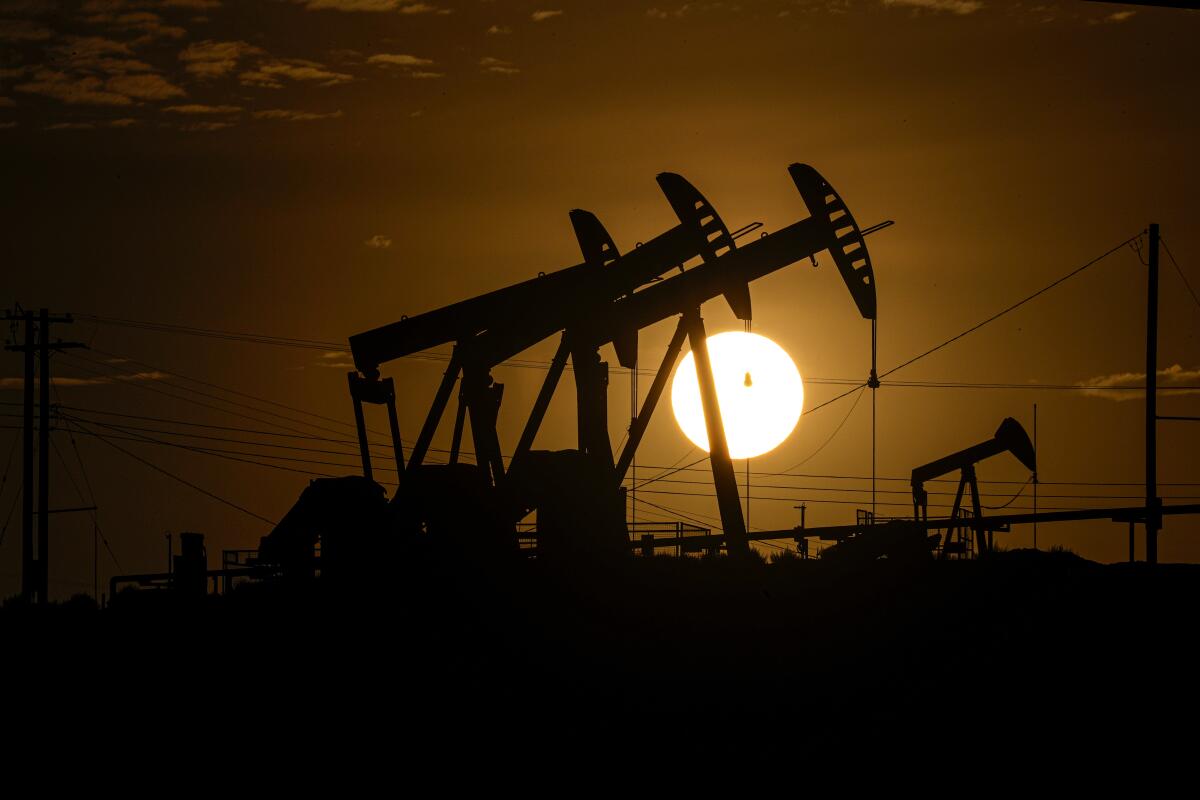
- Share via
This is the Oct. 28, 2021, edition of Boiling Point, a weekly newsletter about climate change and the environment in California and the American West. Sign up here to get it in your inbox.
Four hundred thirteen parts per million.
That’s how much carbon dioxide was built up in Earth’s atmosphere last year — a record 413.2 parts per million on average, according to the latest data from the World Meteorological Organization. That’s up from 280 ppm before the dawn of the fossil fuel era, and it’s brought deadlier heat waves, bigger fires and more destructive floods. When world leaders gather in Glasgow, Scotland, just a few days from now, they’ll be desperately looking for ways to keep the number from rising much higher.
President Biden will be at the climate summit, known as COP26, although with his climate agenda tied up by Sen. Joe Manchin it’s not clear he’ll be able to promise much in the way of American policy. California Gov. Gavin Newsom will be in Glasgow, too, as will Los Angeles Mayor Eric Garcetti, Assembly Speaker Anthony Rendon and various other Golden State Democrats.
Maybe those high-profile Californians will be able to persuade other nations to commit to more aggressive action by pointing to their own climate leadership; maybe not. But I wonder what Newsom and his colleagues will say if asked why the California Democratic Party, their home base, just passed up an opportunity to ban contributions from the fossil fuel industry.
That’s right: Asked this weekend whether they should stop accepting money from oil, gas and coal companies, the executive board of the California Democratic Party voted overwhelmingly to refer the issue to a committee.
It was the latest skirmish in a long-running battle over what it means to show urgency on the climate crisis, the realities of a political system dominated by campaign cash and the continued influence of the fossil fuel industry, even in California.
“We are a deeply Democratic state, and the fossil fuel industry needs to lose its social license,” RL Miller said.
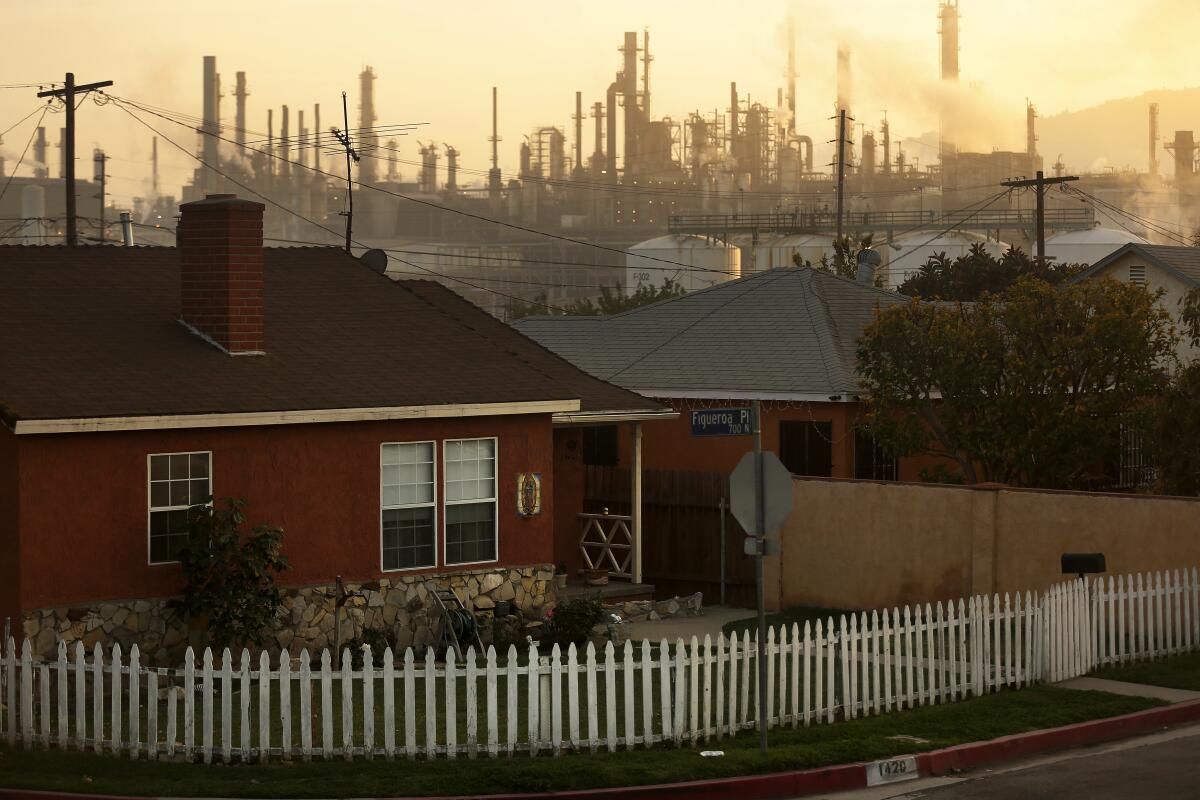
When I spoke with Miller after this weekend’s vote, she was furious. During her eight years as chair of the California Democratic Party’s environmental caucus, she helped create the No Fossil Fuel Money Pledge, which has been signed by thousands of candidates and elected officials across the country, including Biden, Vice President Kamala Harris and Sen. Dianne Feinstein.
The pledge commits politicians to not accepting contributions over $200 from oil, gas and coal executives, lobbyists and political action committees. A version brought before the California Democratic Party’s executive board on Sunday — at a special meeting forced by Miller and fellow climate activists — would have banned contributions over $100, both from the fossil fuel industry and from investor-owned utility companies, specifically Pacific Gas & Electric, Sempra Energy and Southern California Edison.
The three-hour meeting was a giant mess of bureaucracy and Robert’s Rules of Order; watch it yourself if you don’t believe me. Party officials also considered (and deferred to committee) a motion to ban contributions from law enforcement groups.
So what happened, exactly? Here’s the short version: Two days before the Sunday meeting, party Chair Rusty Hicks and his leadership team announced the formation of a committee to study “how we fund the work of our Party in line with the values of our Party.” Then on Sunday, a surprise motion was offered to refer the “no fossil fuel money” proposal to the new committee.
The motion passed overwhelmingly, 63% to 37%. So there would be no vote on the climate pledge, at least not yet.
“We wanted to send a signal to the world just before COP26 that the California Democratic Party is devoted to doing the right thing. And instead this is the message,” Miller said. “The fierce urgency of appointing another committee.”
Supporters of delaying a vote on the climate pledge offered several reasons. They said the question of appropriate funding sources is bigger than fossil fuel companies and law enforcement, and Democrats should also consider whether to keep accepting campaign cash from companies that mistreat their workers and real estate developers, among other sources. They said the party needs a plan to backfill the contributions it might lose, especially as it gears up for midterm elections in November 2022.
“I’m also for getting rid of dirty money in our party, but not for shooting ourselves in the foot how we’re doing it,” said Jimmie Woods-Gray, a past chair of the Los Angeles County Democratic Party.
Other executive board members said there’s no urgency, because the state party hasn’t taken money from a fossil fuel company in a year. Much of the uproar among climate activists was fueled by the party receiving nearly half a million dollars in 2019 and 2020 from Sempra Energy, parent company of Southern California Gas Co. and a growing exporter of liquefied natural gas — but the San Diego firm’s last contribution came in October 2020, according to a Sierra Club database.
“This is not a time-sensitive matter,” said Shanna Ingalsbee, past chair of the Democratic Party of the San Fernando Valley.
One party official — Tomás Oliva, an El Centro City Council member — explicitly defended fossil fuels. He said they “provide a low-cost option for our struggling families” in the rural Imperial Valley, in the form of natural gas water heaters, dryers and stoves. His comments aligned with arguments made by SoCalGas against a transition to all-electric heating and cooking.
“By eliminating completely and saying we don’t want your money, it does shoot ourselves in the foot,” Oliva said.
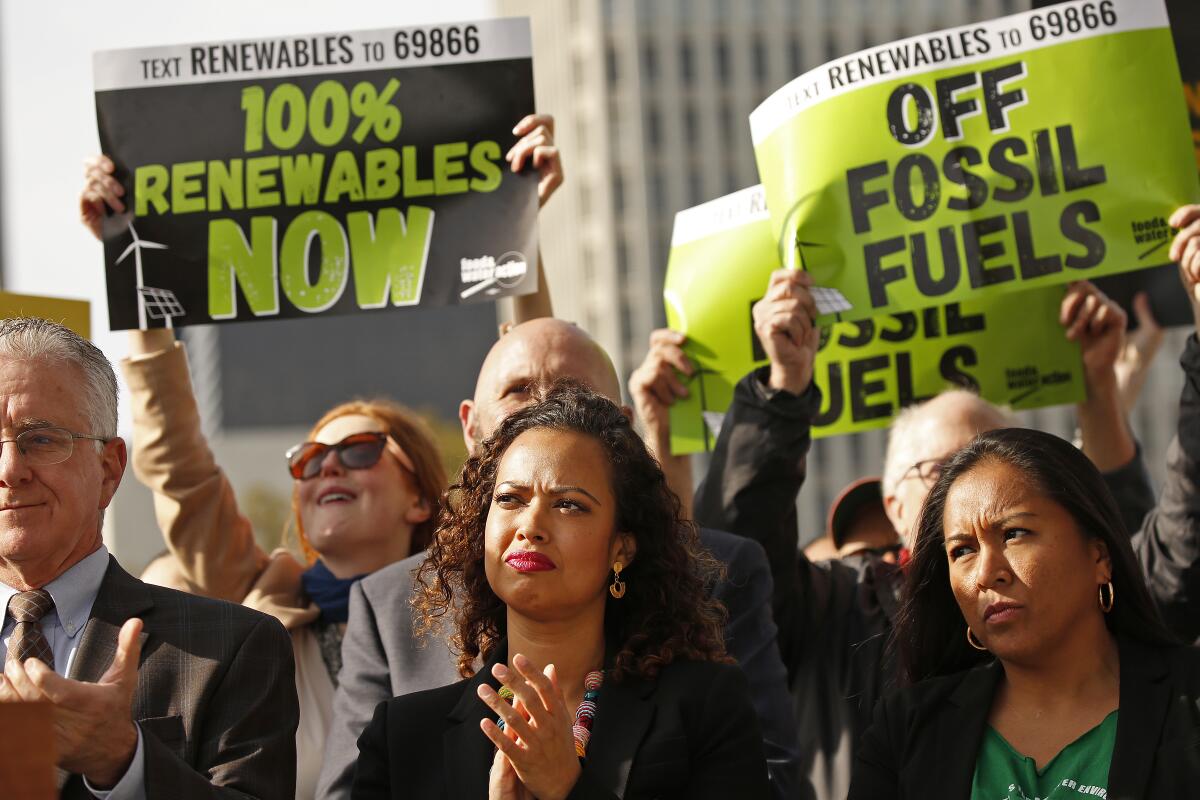
Climate activists countered that the California Democratic Party’s stance on fossil fuel money carries great symbolic weight. Aura Vasquez, a former Los Angeles Department of Water and Power commissioner, said the fossil fuel industry “not only pollutes our environment, but also pollutes our political process.” She noted that oil and gas pollution disproportionately harms low-income people of color, and that state lawmakers, under industry pressure, have failed to pass bills to safeguard at-risk communities.
“Please stand with our communities. We’re fighting for our lives,” Vasquez said.
That call went unheeded, at least on Sunday.
Party leaders say they won’t accept any oil, gas or coal contributions while the new committee studies the issue. The committee has a mandate to report back with recommendations by February, meaning it’s possible a ban is just a few months away.
But Miller’s not optimistic. She’s grown mistrustful of Hicks, the party chair and a former union organizer. Oil and gas workers and their allies across the organized labor movement are a big reason why the fossil fuel industry maintains so much political clout in California, and Miller sees Hicks as an agent of those unions. She’s convinced he choreographed events at Sunday’s meeting so as to delay a decision on rejecting fossil fuel money, without making anyone take an unpopular vote against the climate pledge.
“Rusty is a climate denier. I don’t know how else to say that,” Miller said.

Hicks didn’t respond to my interview request, although I did hear from a party spokesperson. She sent me a written statement from Hicks, in which he said the party is “engaged in a strategic, comprehensive & timely process to ensure we fund the important work of empowering & uplifting [10 million] California Democrats in line with the values enshrined in our Party’s Platform.” He has previously described the state’s climate leadership as “central to the future of our planet.”
I also asked Sempra Energy for comment. I didn’t receive a reply.
By the time you read this, the House Committee on Oversight and Reform will have at least begun a hearing — scheduled for Thursday, Oct. 28, at 9 a.m. Eastern — on the oil industry’s history of climate denial and disinformation. Three days after that, the Glasgow climate summit will begin. Between now and then, Congress may or may not strike a deal on Biden’s climate plans.
So there will be lots of climate news the next few days, and you’ll probably see references to California’s trailblazing efforts — its 100% clean energy law, its support for electric vehicles and its investments in fighting fire and drought.
But as far as climate activists are concerned, California has a long way to go if it truly wants to show global leadership. And in a state as blue as this one, it all comes down to what the Democratic Party is or isn’t willing to support.
Here’s what else is happening around the West:
TOP STORIES
Gov. Gavin Newsom’s administration has proposed requiring new oil and gas wells to be at least 3,200 feet back from homes, schools and healthcare facilities. The long-awaited “setback” rule is designed to protect Californians from the health consequences of breathing fossil fuel fumes, and would also require existing wells within the 3,200-foot buffer zone to adopt expensive monitoring requirements, The Times’ Phil Willon writes. In related news, Alexandria Herr and Clayton Aldern report for Grist that nearly 400 public schools in California — serving a quarter-million students — are within 2,500 feet of an oil or gas well. And the health risks of living near fossil fuel extraction extend well beyond those distances, new Stanford research suggests.
The company at the center of the Orange County oil spill could avoid millions of dollars in liability by filing for bankruptcy — or possibly by cutting loose subsidiaries. Details here from my colleagues Connor Sheets, Laura J. Nelson and Anita Chabria. Meanwhile, Huntington Beach City Council voted to support a ban on new offshore drilling, Matt Szabo reports for The Times.
To see how democracy breaks down in the absence of a fact-based reality that everyone can agree on, look no further than Big Sky Country. The New York Times’ Reid J. Epstein has the disturbing story of how outright lies told by conservative activists and right-wing media fueled a wildly successful campaign against a national heritage area proposed for central Montana, which was intended to promote tourism by celebrating the region’s Western history. And speaking of the importance of facts, a top executive at Fox Weather — the new 24-hour streaming channel being launched by Fox News Media — insisted to my colleague Stephen Battaglio that the station’s meteorologists will offer fact-based information on climate change. Only time will tell.
DROUGHT CENTRAL
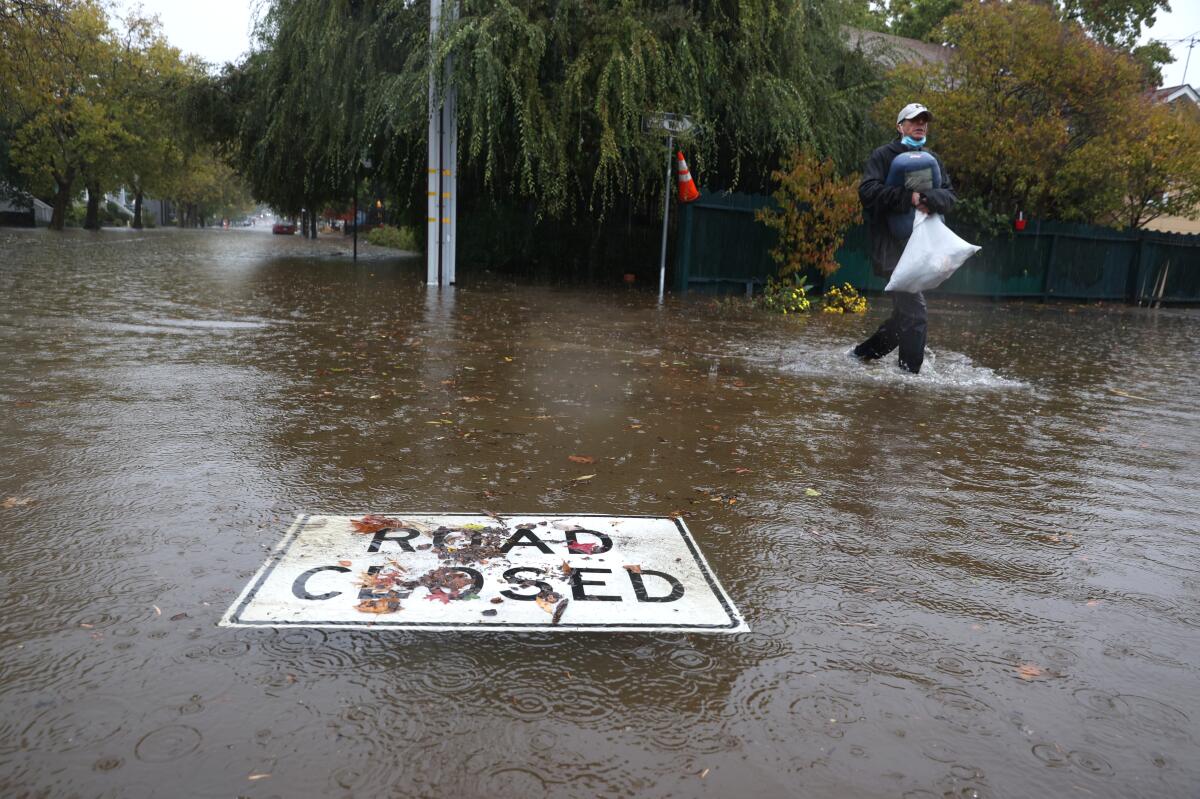
As predicted, fires were followed by floods. Sacramento saw its wettest-ever 24 hours, soon after breaking its record for most consecutive dry days; depleted Lake Oroville rose by 16 feet, although none of it was enough to end the drought, as Hayley Smith, Luke Money and Lila Seidman report for The Times. One scientist told Lila it would take 17 years of above-normal rain and snow to fill Lake Mead, the West’s largest reservoir. The intense rain unleashed mudslides in areas burned by wildfires, creating a risk of toxic runoff from burned-out towns flowing into drinking water supplies, as Lila, Anita Chabria and Susanne Rust report. On a positive note, fire season has likely come to an end for most of Northern California, although SoCal could still see new blazes.
Siskiyou County is doing everything it can to stop illegal pot farms — including cutting off water to Mount Shasta Vista, where cannabis grows proliferate. But are county officials really concerned about fighting crime and the drought, or are they motivated by racism against Hmong farmers? That’s the question at the heart of this story by my colleagues Alex Wigglesworth and Anh Do, with photos by Brian van der Brug. For another example of concerns over alleged water waste, see this story by the AP’s Andrew Selsky and Manuel Valdes about water-sucking Google data centers in an Oregon town along the Columbia River.
California officials deserve praise for putting up billions in cash to pay for drought relief and water resilience, rather than borrowing the money. So says Times columnist George Skelton, who writes that the $5.2 billion for water projects approved by lawmakers this year might have been twice as much if paid for with bonds (and tacked-on interest). Overall, Skelton says state leaders are “thrashing around admirably” on water policy, (mostly) doing the best they can in the face of a harsh climate reality.
ENVIRONMENTAL JUSTICE
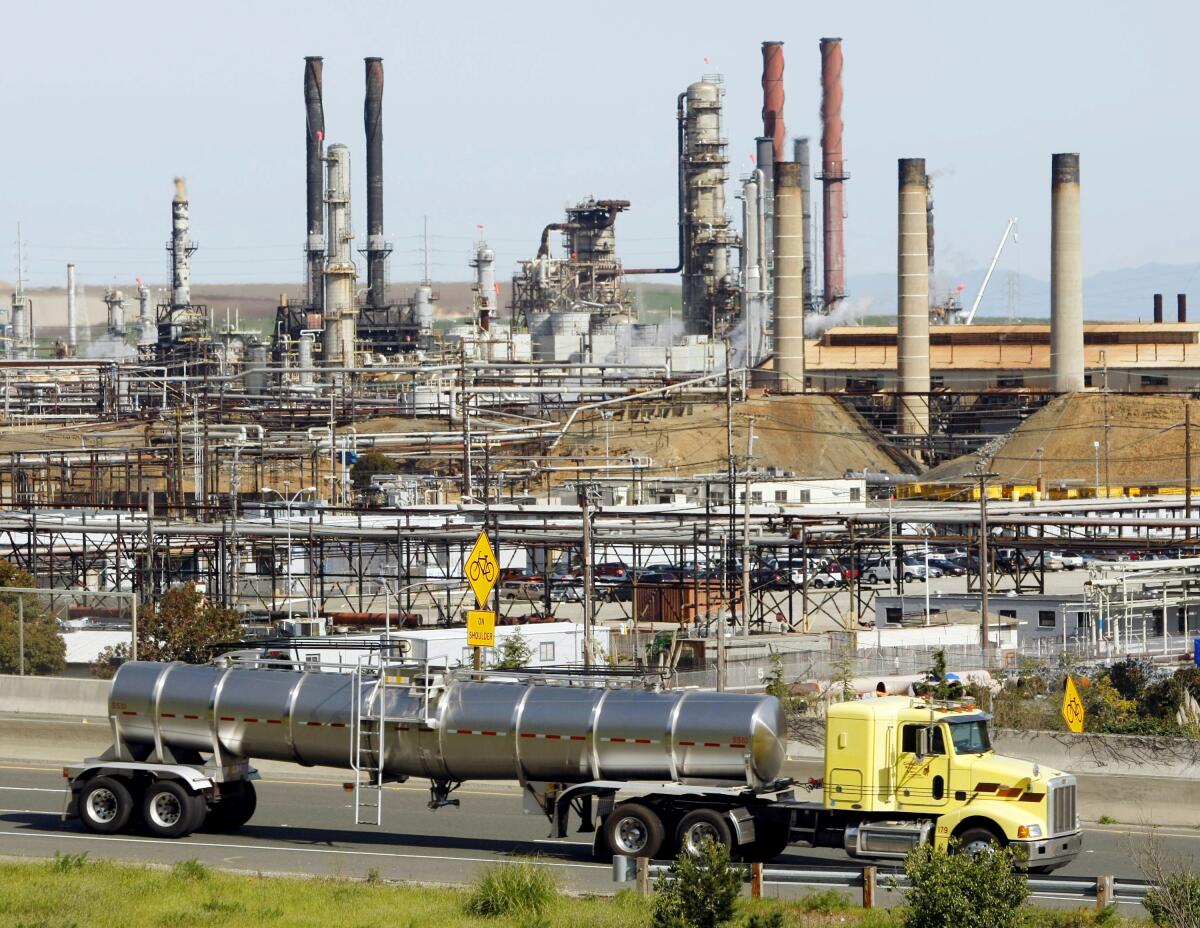
Assembly Bill 617 was supposed to help clean up pollution in California’s most environmentally burdened communities. But the legislation was heavily shaped by the oil and gas industry, and so far it’s largely not working, according to an investigation by Grist’s Naveena Sadasivam. Her reporting focuses on the Bay Area city of Richmond, home to a Chevron oil refinery, where activists say pro-Chevron forces have hijacked the AB 617 process. In another case of environmental injustice, activists are pushing the Orange County city of Santa Ana to clean up lead contamination in Latino neighborhoods, The Times’ Ben Brazil reports.
After initially telling Carson residents that a noxious smell coming from the Dominguez Channel would be gone by this past weekend, L.A. County officials now say there’s no telling when the stench will go away. Here’s the latest from my colleagues Alejandra Reyes-Velarde and Christian Martinez, who note that some residents have filed a class-action lawsuit alleging a warehouse fire caused the smell. Others are confronting local officials over their slow response, Andrew J. Campa reports.
With the Olympics in mind, the Los Angeles Zoo wants to destroy nearly all its remaining native woodlands and build a rock climbing canyon, a vineyard and other attractions. Here’s the surprising story by my colleague Louis Sahagún. Grist’s Adam Mahoney, meanwhile, writes that despite L.A.’s pledge not to build new stadiums for the Olympics, new arenas being built for the Clippers, Rams and Chargers will be used for the Games, and are driving up pollution in Black and brown neighborhoods.
POLITICAL CLIMATE
A wave of climate migrants could inflame international tensions, and the U.S. must support the displaced. That’s the main takeaway from a comprehensive new analysis by national security officials, as chronicled by The Times’ Anna M. Phillips. It’s one of many reasons the Biden administration is scrambling to piece together new climate proposals in the face of Sen. Joe Manchin’s opposition to much of its “Build Back Better” program. But as Anna and Jennifer Haberkorn write in this clear-eyed analysis, “reducing the scope of the climate provisions would defeat the purpose of dramatically reducing greenhouse gas emissions.”
The California Public Utilities Commission made a big deal this summer about how it was requiring utilities to bring 11,500 megawatts of new power online to help keep the lights on — all of it emissions-free. Well, now the agency is thinking about allowing some natural gas in the mix, to the consternation of climate activists, Kavya Balaraman reports for Utility Dive. Elsewhere on the Western power grid, some rural communities can expect to see significant electricity rate increases as drought saps the capacity of hydropower dams and California gobbles up energy to avoid blackouts, Brian Maffly reports for the Salt Lake Tribune.
Congress held a hearing on the legacy of U.S. nuclear testing in the Marshall Islands — and the results were bizarre. One arm of the Biden administration said America has no legal responsibility for the radioactive waste left behind, and another arm of the Biden administration said that’s not true, The Times’ Susanne Rust reports. See also Susanne’s 2019 investigation, which revealed that a dome holding 3.1 million cubic feet of radioactive waste is leaking, and increasingly vulnerable to sea level rise.
ONE MORE THING

If you’re anything like me, you’ve tried and thus far failed to give up meat, or at least to cut back on meat consumption. You know how much carbon was spewed into the atmosphere to make that hamburger on your plate, but gosh does it look delicious.
So kudos to the L.A. Times Food team, which just published an excellent package on the future of cultured and plant-based meats. Read their stories on the best and worst alternative proteins, where to find meat substitutes at fast-casual restaurants, why California is the capital of fake meat and more. Even if you’re just looking for an alternative to In-N-Out, it’s worthwhile reading.
We’ll be back in your inbox next week. If you enjoyed this newsletter, please consider forwarding it to your friends and colleagues.




